BC Supreme Court establishes precedent in KSA v. CFS-BC ruling
January 23, 2010 by Sarah Jackson · Leave a Comment

Derek Robertson holds up the victory sign after the BC Supreme Court ruled in favour of the KSA, ordering him to be accepted as Kwantlen's representative on the CFS-BC's board of directors immediately. (Sarah Jackson photo)
The B.C. Supreme Court ruled in favour of the Kwantlen Student Association Wednesday morning, putting an end to a two-year dispute over the Canadian Federation of Students-B.C. Component’s refusal to accept Derek Robertson, the student associations’s representative, on its board of directors.
Madame Justice Brown’s decision, stated that the CFS-BC board of directors was in violation of section 24 of the Society Act-BC and the CFS-BC’s own bylaws. The ruling set a precedent that bars societies in B.C. from applying provisions beyond those set in the Society Act-B.C. to determine qualification for appointment to a board of directors or membership of a society.
Brown awarded the KSA with Robertson’s appointment to the board of directors and legal costs associated with the court petition.
“We’re perplexed,” said Shamus Reid, chairperson for the CFS-BC. “The B.C. Society Act provides that directors of society are legally responsible for protecting the society from harm.”
Robertson, director of external affairs for the KSA and ex-officio representative for the CFS-BC, held office on the board of directors for the CFS-BC previous to a conflict of interest in February 2008, when he resigned to campaign to have the KSA leave the CFS.
Following a referendum, which reaffirmed Kwantlen students’ interest in remaining members of the CFS, Robertson’s nomination to rejoin the board of directors was not ratified by the CFS-BC.
“He intended to do damage to society in all comments. The only check against that is the ratification process,” said Reid.
Many other societies in B.C. have a dual ratification process, he added. “This ruling will have a profound negative consequence for societies all across B.C.”
Robertson said he is thrilled about the decision. “I’ve been quite discouraged by the fact that Kwantlen has been without a representative for almost two years. I have to keep in mind that I do now have obligations to both societies. I am there to represent the views of Kwantlen students and that’s exactly what I’m going to do.”
He admitted that he doubts Kwantlen students will notice any difference in benefits from their CFS membership. “A representative on the board of directors is simply a symbolic thing… The CFS will go on with business as usual.”
Reid is also concerned about whether Kwantlen students will see any improvement in the benefits they receive. He said Robertson has made it difficult for the CFS to be on campus but it will be a priority to ensure that members have access to services they are entitled to “regardless of whether the local leadership is being antagonistic.”
“I don’t like to speculate on the judge’s background and experience, but I certainly think that this ruling doesn’t show a familiarity with the societies system within B.C.,” he said. “Any court ruling that overturns the democratic rule of a majority ruling is not in the best interest of society so we don’t think that is an appropriate ruling to make.”
Robertson considered the court battle, which included screenshots of his membership in anti-CFS Facebook groups, “a hail Mary.” The KSA focused on the law in the Society Act regarding requirements for being a director of a society, he said.
“The CFS cannot prevent diverging views from the board of directors anymore, which I’m sure they’ve been doing.”
The CFS-BC is honouring the ruling but will be “evaluating our legal options,” said Reid, hinting at the possibility of an appeal.
“We accept that at this point Mr. Robertson is the director and we certainly expect that he will uphold his responsibilities, though I believe that he has shown inability to do that in the past,” he said.
Robertson’s current term as director of external affairs and ex-officio representative for the CFS-BC will end on March 31, 2010.
Kwantlen, KSA distribute on-campus H1N1 vaccines
January 20, 2010 by Jacob Zinn · Leave a Comment
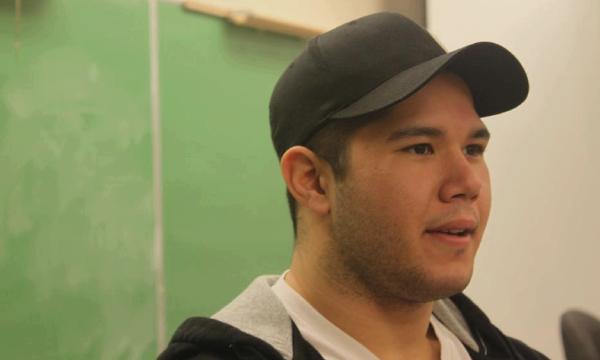
Brandon Tuason, a history and arts student, thinks it's important for students to get the H1N1 vaccine and keep from spreading the virus through the student population. (Jacob Zinn photo)
In a joint effort, Kwantlen Polytechnic University and the KSA are providing free H1N1 vaccinations this week to students and employees at all four campuses.
Since Tuesday, more than a hundred on-vaccinations have been administered at the Surrey and Richmond campuses.
Lesley England, a registered nurse with ProGroup, said the turnout for vaccinations has been quite good. On Monday, she expected to give 70 vaccinations at the Surrey campus. She gave 88.
By 12:30 p.m. on Tuesday, she’d vaccinated another 45 students on the Richmond campus.
“A lot of people who are getting the H1N1 [vaccine] have never had flu vaccines before,” said England, who is expecting a third wave of the H1N1 influenza virus to arrive in February.
Nurses will visit the Langley campus Thursday and the Cloverdale campus Friday in hopes of immunizing procrastinating students.
When the H1N1 vaccine was being developed last fall, the KSA hoped to include it in the health and dental plan. However, the government purchased enough of the vaccine for all Canadians and offered it for free at clinics.
“It’s readily available now. You can go to your doctor and get the shot,” said Eddie Lee, coordinator of the Student Health Improvement Program.
“However, we know that there are students and employees who probably still won’t go–it’s a lack of convenience for them, so we decided to bring it on campus.”
It’s that inconvenience that has kept Nick Mostar, 22, from finding time for the vaccination.
“I’ve been doing schoolwork and haven’t really had the time to go to a clinic or anything,” said Mostar who is in the engineering program.
Not all students have waited quite as long. Brandon Tuason, 21, got the H1N1 vaccine several months ago. He was at risk of getting the virus because, at birth, he was diagnosed with severe asthma, making him more prone to infection.
“We’re in an environment where everybody’s kinda in close quarters,” said Tuason. “Infections can spread really quickly. I think the school is taking a good initiative in preventing a lot of that by giving the immunization away.”
Students are learning more, but in danger of info overload
January 14, 2010 by Mitch Thompson · Leave a Comment

The overall population breakdown of Kwantlen Polytechnic University, based on age.
Almost half of Kwantlen students are members of Generations Y and Z, according to figures from the Institutional Analysis and Planning department, and were born into a world of personal computers and an explosion of information.
Generation Y includes people born between 1980 and 1989; Generation Z is those born in 1990 and subsequent years. Student records show that 48.8 per cent of Kwantlen students were born between 1988 and 1992.
The Y and Z designations came from a need for a distinction between the Baby Boomers, who were born after World War Two, and their children, who were born between 1965 and 1980. Those children have been called the “after-boomers.â€
Canadian author Douglas Coupland coined the phrase Generation X in his 1991 novel Generation X: Tales for an Accelerated Culture. He believed the title signified the seemingly contradictory ways of post baby-boom society.
The name caught on,and the Y and Z labels followed.
According to an article on About. com, a New York Times-run website, Gen-Yers value family time and teamwork. Generation Z, however, is more individualistic and puts less stock in family values, according to an article in Australia’s Herald Sun.
But there is one overarching value that the generations share.
“The main value, given their age, is probably a thirst for knowledge and looking for means of meaningful self-expression,†said Peter Clayton, a Kwantlen instructor whose courses focus on media and sociology.
This need to know manifests itself in the widespread use of the Internet to discover information and communicate ideas to others.
“The more serious-minded of them spend an enormous amount of time online in the quest for knowledge,†said Clayton.
The older ways of researching, using libraries and books, are slowly being phased out in favour of websites such as Wikipedia or Google.
It’s a change that allows them to learn while delivering the content in a way that is culturally relevant to them, explained Clayton.
However, this cultural inclination towards technology has created never-before-seen consequences for those of Generations Y and Z.
“The downside of all the information technology is that, as far as
leisure time is concerned, people spend more time on their own,†said Clayton.
Generations Y and Z are characterized by physical isolation.
Though they may be talking to friends online, they are still alone at a computer, which can have a negative effect on how they socialize in public.
“On one hand [their culture] encourages them to be more outward-looking,†said Clayton. “But on the other hand, it encourages them to be more isolated and inward-looking.â€
As well, constant access to the Internet has created two generations that suffer from information overload, Clayton said.
“They are probably a lot more stressed out than they realize,†he said. The two generations have become walking dichotomies, Clayton believes, as they want to learn as much as possible, but suffer from extreme information overload.
A thrift-store romance: How to impress the other gender when your budget is slender
January 13, 2010 by Mitch Thompson · Leave a Comment
The art of wooing can be expensive, especially for a poor university student, but creativity and a little pocket change can go a long way.
According to Sheree Morgan, a Vancouver-based professional matchmaker, the best place to start looking for value dates is away from screens or dinner tables.
“The best place for low-budget ideas is outdoors,†Morgan said.
With the large number of walking paths, hiking trails and parks in the Lower Mainland, there is something for all fitness levels.
Remembering your date’s physical prowess is important, as Soraya Raiszadeh, a Kwantlen student, knows well.
The thrifty outdoor excursion Raiszadeh went on included the infamous Grouse Grind.
“I wouldn’t say it was the best way to go on a date,†she joked.
Raiszadeh is one of 13 Kwantlen students asked by the Chronicle about the cheapest, most effective date they had been on. For the purpose of the poll, “effective†means that it lead to other dates, or was enjoyed by both parties.
Dana Stasyk, a first-year Public Relations student, was also courted outdoors. She was in Australia and, met a man named Pok, who took her for a stroll on the beach. “He had laid down a picnic at the end of the walk,†said Stasyk. “It was very sweet.â€
Romantic as woodland walks can be, Morgan does have one important tip. “Make sure you stick to the paths,†she cautioned. “It really kills the moment if you have to be rescued. Probably not a great way to end the date.â€
Going outside is one way that dates can be cost-efficient. The other involves a bit more inventiveness.
“Women love it if you’re a little bit creative,†said Morgan.
She used a past date she had been on to emphasize her point. “After a fresh snowfall, dress up really warm, take a thermos of hot chocolate and go to Stanley Park. I’d never done it before, and it’s probably one of the most wonderful things I’ve ever done,†she said. “It didn’t cost any money, it just took a little bit of thought.â€
Kaitlyn Cook, one of the interviewed Kwantlen students, also enjoyed a date that was simple, but memorable. Her date took her skating, but was absolutely awful at it. Luckily, Cook used to figure skate and they spent the date with her teaching him. “I don’t know, maybe he was faking, but it still made me feel special,†she said.
In fact, almost all of the students polled enjoyed the simple dates as much or more than the most expensive ones they had ever been on.
Ryan Cardoz, a business student, once took his date to Costco for hot dogs. The whole meal cost him a wallet-destroying $3.20.
“It was pretty effective,†Cardoz said. “We were both poor at the time.â€
The date was so good, he ranked it as high as the $240 meal at a downtown restaurant to which he later took the same woman.
Echoing his statement was George Pauol, a psychology major, who felt that the day trip he took with his girlfriend to Victoria was less enjoyable than just walking around the mall with her. He said that because of all the tourist attractions, they were both distracted and there was less time for conversation.
For many of those polled, good conversation with a person who would listen and make them laugh was essential to ongoing interest.
“Be very talkative, because I am a chatterbox,†said Rasizedah.
“As long as we can talk without feeling awkward, it’s cool,†said Alvin Denbock, a business student.
“If she’s interested in me, it makes her seem interesting,†said Cardoz.
“Make me laugh and you’ll get a shot. Don’t make me laugh, and you’ll never see me again,†said Cook.
Can several dollars worth of hot dogs and good conversation really be the Holy Grail of thrifty dating?
Morgan, the matchmaker whose focus is on finding clients a single, compatible match, agrees with the conversation part. “Be as positive as possible. Make it fun. We all want to be around somebody who is confident,†she said.
According to one of the polled students, it’s not about the content of the date, but the quality of the person next to you.
Kwantlen mascot needs a name
January 13, 2010 by Kirk Darbyshire · 1 Comment
The Kwantlen Eagles mascot is in need of a name and the athletics department is challenging students to come up with it, offering an iPod touch to the winner.
The mascot, which was designed by a collaboration of student opinions, is a giant eagle that has been nameless since its first appearance last September at a school sporting event.
“We feel that this is a great opportunity for students to get involved and show their school spirit,†said Katlyn Moore, Kwantlen’s athletic director.
The contest requires students to submit their suggested names to the athletic department web site before the Jan. 15 deadline. Once all the name ideas have been reviewed, the athletics department will post the 10 finalists on the Kwantlen website and students will be able to vote for their favourite.
“The response has been really good,†said Moore, who claims there have been over 60 unique names suggested already.
The winning name will be announced on Jan. 29 at the same time as the school raises the Kwantlen women’s soccer team’s championship banner in the Surrey gymnasium prior to both the men’s and women’s basketball games against Vancouver Island University.
H1N1 vaccine might be free for students
January 4, 2010 by Jacob Zinn · Leave a Comment
If H1N1 injections became available to Kwantlen students, they might be covered under the existing student health plan.
The Kwantlen Student Association is looking into the possibility of including H1N1 vaccines in student health benefits. The KSA has contacted Gallivan & Associates, Kwantlen’s health and dental insurance company, and hopes to negotiate the vaccine’s inclusion, should it become widely available.
“We’ve taken steps to make a change to the plan so that that cost would be at least partially or wholly covered by the KSA,†said KSA general manager Desmond Rodenbour.
If the H1N1 vaccine is added to the benefits, Kwantlen will direct students to vaccination clinics for the shot. Rodenbour said he hopes all full-time students on the medical plan would be eligible to receive the immunization.
Currently, the vaccine is still being developed and the KSA doesn’t have a projected cost
for the shot, but it’s expected to be generally available later in the fall. The Public Health Agency of Canada reports that the government intends to purchase 50.4 million doses of the vaccine, enough to cover the population of Canada.
Linda McCannell, a program leader in communicable disease for the Richmond Health Department, said she doesn’t think people in good health should be as concerned about getting infected as those who are illness-prone.
“From what I’ve seen, the severity [of H1N1] tends to be very similar to regular flu,†she said. “It’s pregnant women, it’s children two years of age, it’s people with chronic health problems and those are who we normally immunize for flu [who might have a more severe reaction].â€
Janine Hadfield, a coordinator of the Kwantlen Wellness Centre, said the regular seasonal flu shots will be given on campus near the end of October or early November.
Last year, about 180 staff and students got flu shots on-campus, according to Eddie Lee of the Student Health Improvement Program.
Lee said the number of people getting the shot might increase because of the awareness of the flu virus.
Lee estimated the flu shot will cost $15 to $20, adding that the KSA will subsidize some of the cost for students on the health plan.
Kwantlen is promoting good hygiene, such as washing your hands and covering your mouth when you cough, as defences against the flu in general and H1N1 in particular. Automated hand-sanitizer stations have been installed at main entrances and updates about influenza are available on the Kwantlen website (www. kwantlen.ca/hr/ohs/h1n1.html).
“The primary thing is education,†said Peter Chevrier, Kwantlen’s director of marketing and communications. “If we educate everybody on some of the really fundamental, basic processes, you start to cut down on the likelihood of infection.â€
According to Kwantlen’s Influenza Exposure Control Plan, the Emergency Management Committee would issue a health notice in the event of a major flu epidemic.
Students should be concerned if they have a fever above 38 C and any other H1N1 symptom such as cough or shortness of breath. Suspected and confirmed cases should be reported immediately to Healthlink BC at 8-1-1 and the manager of Kwantlen’s Occupational Health & Safety Office at (604) 599-2924.
Much of the Influenza Exposure Control Plan is about precautions to stop the spread before it starts.
Local and regional health authorities would decide if school closures are needed. Kwantlen, however, is not restricted from implementing its own preventive measures, said Chevrier.
“We have a lot of freedom to do what we feel is the best in order to provide a level of commitment to the health and safety of our students,†he said.
He added that the janitorial crews have been trained for more thorough and frequent decontamination, such as sanitizing doorknobs and handrails.
The Public Health Agency of Canada has reported five cases of H1N1 in B.C. There are no reports of H1N1 affecting anyone at Kwantlen.
Lucky ones win chance to buy Olympic tickets today
December 14, 2009 by Kirk Darbyshire · 1 Comment

(Left to right) Maggie Fung, executive director of IET, Desiree Yu, public information assistant of marketing and communication, Linda Gomes, executive assistant of finance and administration, oversee Monday's Olympic ticket draw on Surrey campus. (Kirk Darbyshire photo)
If you are a student or employee of Kwantlen, and Monday is your lucky day, you may have gotten a chance to buy tickets to the 2010 Olympic Games.
A total of 1,118 students and 264 employees entered their names in the draw for tickets to the 57 events available to Kwantlen for the upcoming winter games, according to Peter Chevrier, director of marketing and communications for Kwantlen.
People who won the right to purchase tickets were being notified by e-mail late in the day Monday and will have seven days to decide whether to purchase the offered tickets or not.
If the first person passes on the tickets, then they will be offered to a second person, selected by the random number generating computer software, and so on until all tickets are purchased.
Hockey was the most requested event in the draw, with 844 people requesting tickets to the men’s gold medal game. The least requested event was figure skating with only 333 people putting their names forward for tickets the men’s short program.
The draw, which took place on Kwantlen’s Surrey campus, was witness by two people who weren’t participating in the ticket lottery, to ensure accuracy and fairness.
Kwantlen soccer field plans in the works
December 7, 2009 by Katie Lawrence · 2 Comments
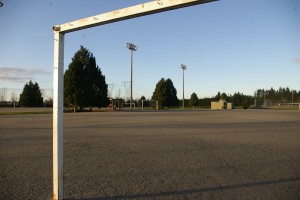
The gravel fields at Newton Athletic Park (NAP) could be the future home of Kwantlen's own turf field. NAP is about two minutes away from the Surrey campus. (Katie Lawrence photo)
Plans are being drawn up between Kwantlen and the City of Surrey to put a turf soccer field at Newton Athletic Park, down the street from the Surrey campus.
Nothing is official yet, but Gordon Lee, vice-president of finance and administration at Kwantlen, feels that partnering with the city to build the field for Kwantlen’s use would greatly benefit the school.
“We have never put a lot of money into athletics. Over the past 10 years, we’ve created a gym at one campus, and we’ve developed varsity teams in four sports (basketball, soccer, badminton and golf), but again, we have never invested much in facilities,” said Lee.
Lee said that the new field would include a Kwantlen scoreboard, the university’s logo at midfield and seating for 500, but the field wouldn’t be used exclusively by Kwantlen. Since the school is sharing the cost of the field, which Lee estimates to be around $2.5 million, with the city, Surrey soccer teams would be able to use the field. Kwantlen would have priority on which times they get the field.
“The city will go ahead if we don’t partner with them, although we do think it is in the interest of the university to enter into a partnership arrangement with the city to gain access to a field which we can use that would be ours,” Lee said.
For the past five to seven years, Kwantlen has been looking into putting in an athletic field for the school’s use, but there are a couple of challenges that need to be overcome before anything can be put into action.
“There’s not a lot of space and, unfortunately, we need the space right now for parking lots,” said Lee. “The other issue is the cost of putting in a turf field, which is really the only way to go in our climate.”
But now that the field can be built at Newton Athletic Park and with cost-sharing with Surrey, both of those challenges seem to be remedied. All that’s necessary for field construction to start is a stamp of approval from Kwantlen’s Board of Governors.
Lee said Kwantlen’s share of the field cost will be taken out of university resources; none of the money will come out the students’ pockets.
If everything goes ahead as planned, construction of the field will start early in the new year and it should be ready for the 2010 soccer season.
In the future, Lee said that Kwantlen hopes to expand fitness and sports facilities at all campuses to get everyone involved in either competitive or recreational sports, but the problem is the lack of space.
“The Richmond campus is even more of a problem, because there’s no land space around there at all. We have been talking with the City of Richmond about using the Oval after the Olympics and that’s a big possibility for the indoor sports,” he said.
Video: Kwantlen at belt level
December 2, 2009 by Mitch Thompson · Leave a Comment
Emily Brook is a Kwantlen student who, due to a lifelong disability, relies on a wheelchair for mobility. Here she discusses her disability, as well as the issues of being wheelchair-bound, a state she did not choose but which defines how others see her.
Surrey buildings lose letters, gain tree names
December 1, 2009 by Kirk Darbyshire · 1 Comment
This week on the Surrey campus, room numbers won’t change but the names on the buildings they’re in will.
In May, Kwantlen announced planned name changes for all of the buildings on the schools Surrey campus. Over the next week signage will be updated to reflect the changes.
Building C has already been dedicated as Surrey Main, and this week the remainder of the buildings will lose their letters in favour of the names of trees indigenous to British Columbia.
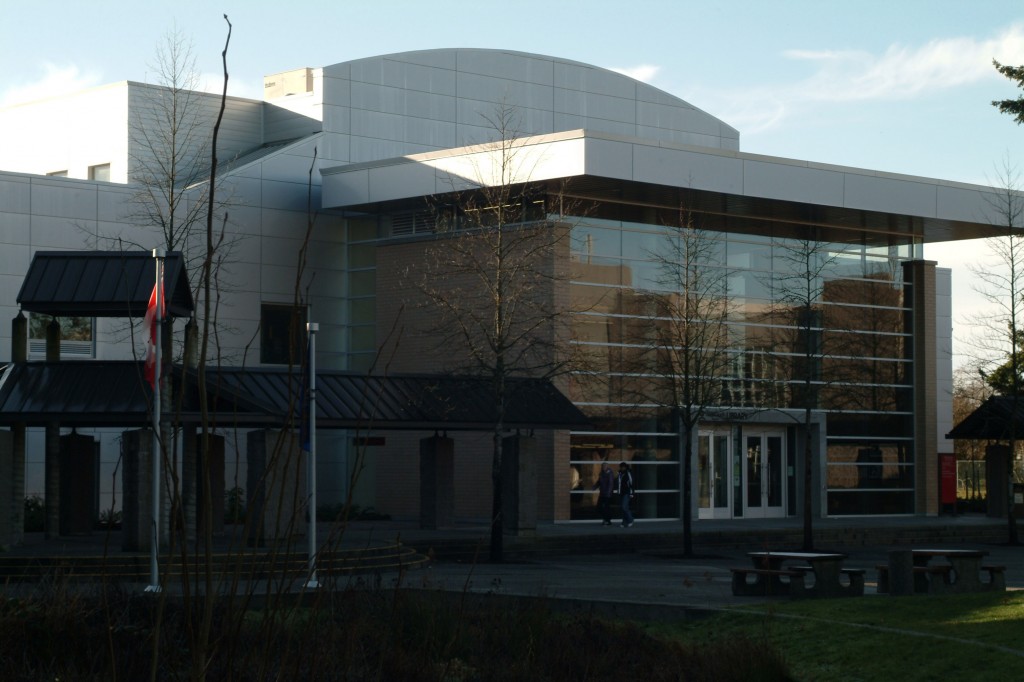
Building A is now Arbutus. Arbutus building is where the Coast Capital Savings Library is located. The name Arbutus was chosen because the tree is Canada’s only broad-leafed evergreen tree. It also has historically meaning for the coastal Salish peoples in regards to medicine and mythology. (Kirk Darbyshire photo)
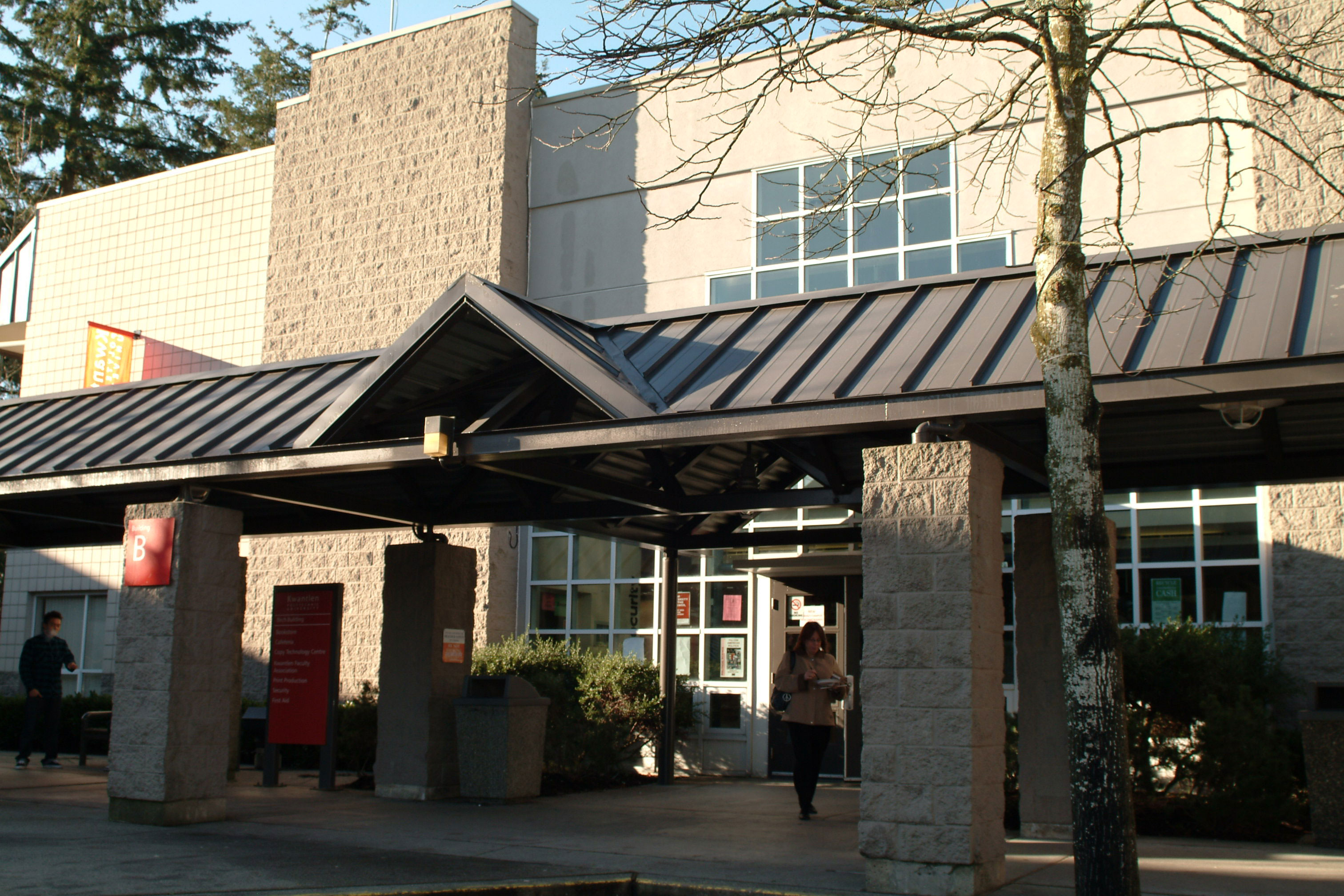
Building B is now Birch. Birch building is where the Kwantlen bookstore and Chartwells Café can be found. “Bright white and shining†is the ancient European meaning for the word birch. Birch was chosen as a name due to the nearly imperishable nature of the tree's bark. It also has historical roots in many cultures including being used to make canoes, tools and musical instruments. (Kirk Darbyshire photo)

Building D is now Fir. Fir makes up half of the academic learning building and is located in the courtyard close to the school's pond. Fir was chosen as a name because the tree is the most commercially important in western North America. Historically, Douglas Firs have the reputation of being the largest of all trees. Even though giant firs are a thing of the past due to over-foresting, stories of the towering trees climbing over 400 feet into the air are still told. (Kirk Darbyshire photo)

Building E is now Spruce. Spruce is connected to Fir and makes up the other half of the academic learning building. Spruce was selected as a name because of the tree's familiarity to many people and its most common use -- the Christmas tree. Spruce is also well known for its musical applications. Instruments such as cellos, guitars, mandolins and even Stradivarius violins are made from this wood due to its distinctive resonant qualities. (Kirk Darbyshire photo)

Building F is now Yew. Yew building may be a small storage building but no one would ever know that by the name chosen for it. Yew was a symbolic tree revered by the Egyptians, ancient Greeks and early Christians as the tree of everlasting life. (Kirk Darbyshire photo)
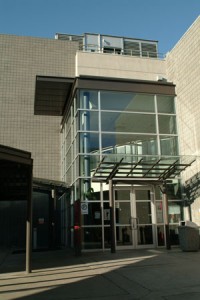
Building G is now Cedar. Cedar building is home to the gymnasium, KSA offices, and the Grass Roots Café. Cedar was selected as the name for one of Kwantlen's busiest buildings because of its historical importance to the First Nations People of the Pacific Northwest. Sometimes referred to as the long life giver, cedar had many uses across many cultures. (Kirk Darbyshire photo)


